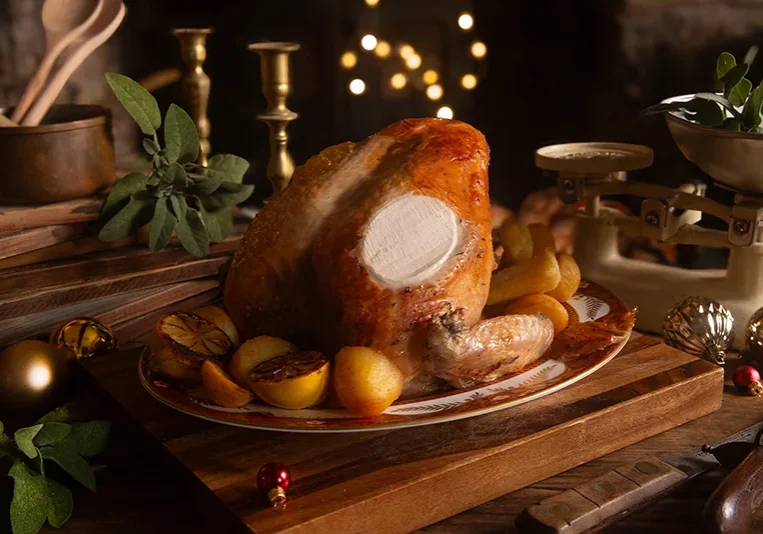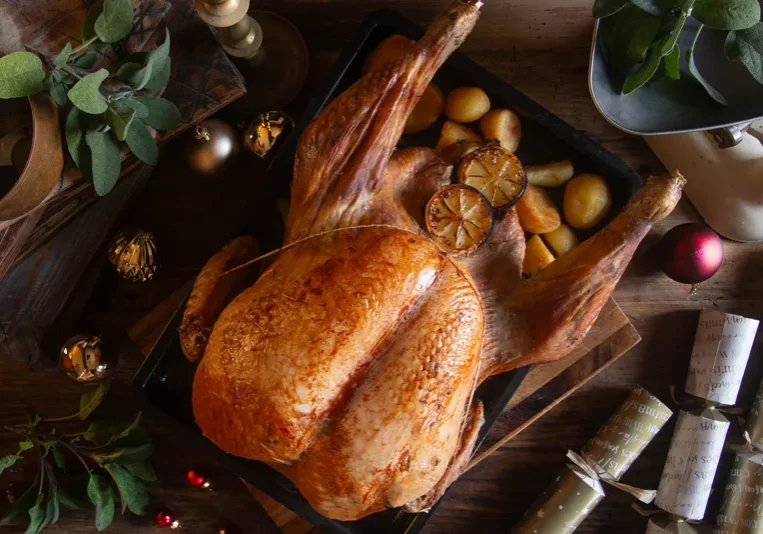Many of us will be looking to treat our families and friends to a special Christmas dinner, however, we are often left wondering what the costs are behind our indulgent treats.
We wanted to provide you with an honest overview of the cost so that you know where your hard-earned cash is being spent this Christmas.
Research by money supermarket found that nearly 30% of us spent more than £30 to £60 per head at Christmas, while a further 8% spent between £70 to £100 per head. Sitting with family and friends and sharing a special meal can greatly improve our overall well-being.
So why does a traditionally reared free-range turkey cost up to 40% more than a supermarket turkey?
A traditionally reared free-range turkey is reared for up to three times the age of a commercially reared turkey that is bought in a supermarket. Therefore, many of these costs are more than trebled! The feed cost of a slow grown turkey is around £11 per bird while the feed costs of a commercially reared bird would be 50% less than this. The customer is paying for lower meat to bone ratio with the supermarket option. The slow grown turkey will yield up to 50% more meat than the commercially produced turkey. The bone to meat ratio is far greater on a slow grown turkey.
A traditionally slow grown turkey, reared for 26 weeks, incurs significantly higher labour costs than a turkey that is reared for around 12 weeks. Many slow grown producers manually feed their turkeys and do not have automated feeding systems. Straw bedding is distributed by hand as machine bedders can adversely impact on the welfare of turkeys. Labour costs are also greater as the turkeys are outside for a longer period. Each night they require to be shepherded into their housing so that they are safe from predators.
Overall, farm production costs can be up to £5 a turkey in a slow-growing operation
Commercially reared turkeys are de-feathered using hot water and chemicals. This is called ‘wet plucking’. This is an extremely cost-effective process. However, the outer layer of the skin is removed which means the turkey will dry out when cooked. Turkeys cannot be game hung following the wet plucking of a turkey as the shelf life is dramatically decreased following this process. Instead, the guts are removed immediately after this process with automated equipment. This prevents the meat from maturing. Consequently, the meat has less flavour.
The cost of increased wages has had less impact on commercial producers as they utilise automated plants in production and processing.
Dry plucking and delayed evisceration are up to 7 times more costly than wet plucking. The process is labour intensive and requires large volumes of labour to undertake this job for the Christmas market. Each turkey is individually finished by hand so the turkey can then be game hung. Dry plucking ensures that the outer skin is kept intact which is vital for holding in the juices of the turkey when cooked. Game hanging allows the meat to mature and enriches the flavour. It also tenderises the meat and allows the muscle fibres to break down over time. There is no automated equipment to remove the guts of the turkey following delayed evisceration. Therefore, the guts must be removed by hand which results in soaring labour costs. Following, the costs of plucking, evisceration and packing, a traditional producer can expect to pay up to £13 per turkey.
The ‘game hanging’ process results in up to 6% of the carcass weight being lost through moisture while the moisture in commercially reared turkey is retained. When a supermarket turkey is cooked, the moisture is released and passed through the meat. This results in the meat drying out. Customers are effectively paying for that moisture within the weight of the supermarket turkey.
The mass production of commercially reared turkeys ensures that producers can take advantage of economies of scale. This helps to reduce their production costs. Large commercial producers will gain better prices for day-old chicks, feed, gas, bedding, packaging and distribution.
Final Thoughts
Production is inevitably higher for smaller independent producers that follow traditional methods. However, these producers provide us with a unique product that differs greatly from the daily produce that is available to us in the supermarket. This is undeniably a special treat for Christmas dinner in 2023, that one can share with family and friends.
Each small independent producer provides a very real and distinct flavour of where the bird has been reared. This is vital in an age where the mass production of food has dramatically reduced the quality of our diet but provided us with cheaper produce.




Share: